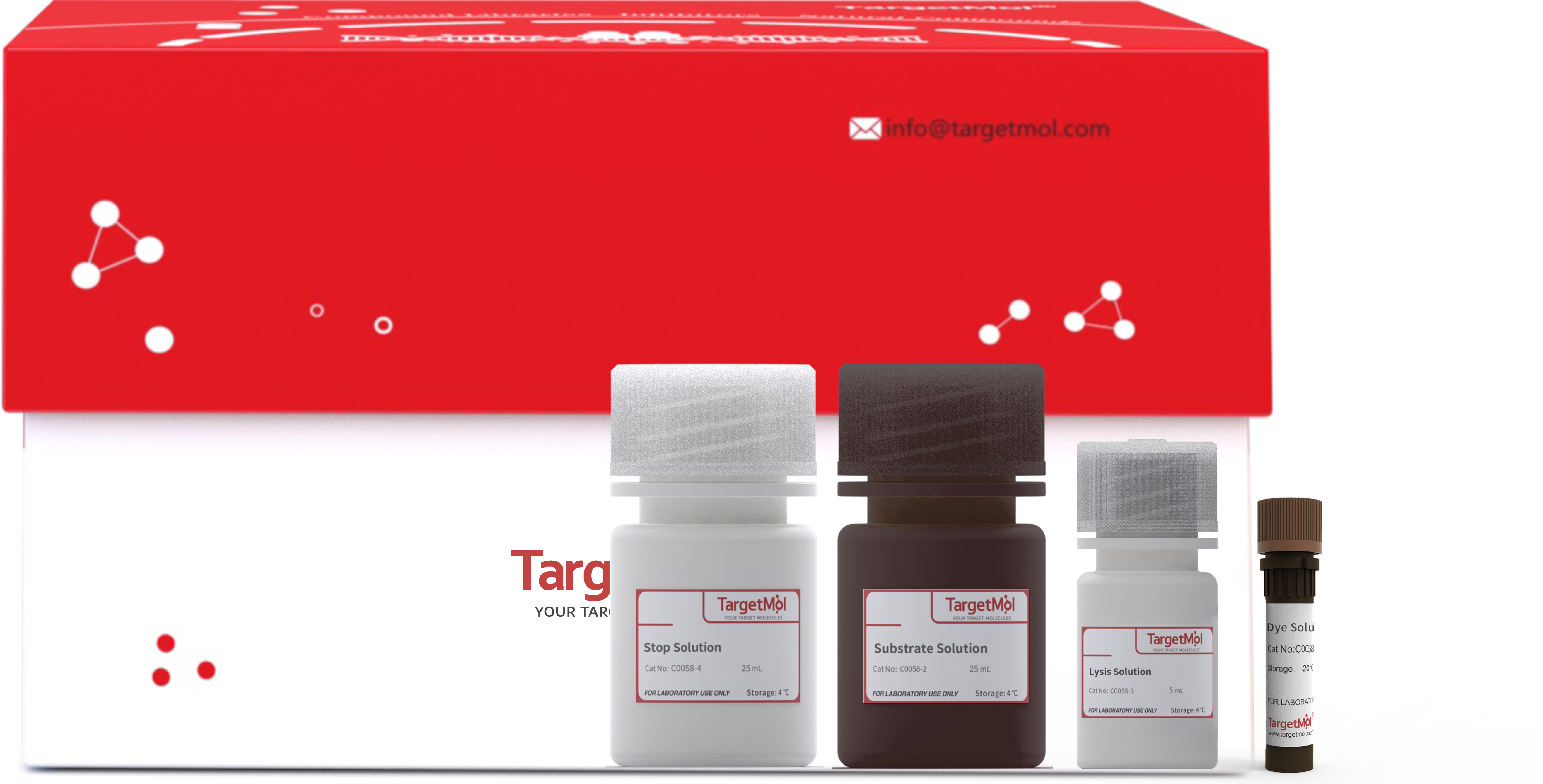 Your shopping cart is currently empty
Your shopping cart is currently empty


LDH Cytotoxicity Assay Kit
This assay kit is based on the LDH-catalyzed reaction in which lactate is converted to pyruvate with the concomitant reduction of NAD⁺to NADH. The resulting NADH then reacts with INT to produce an orange-red colored compound, formazan. Formazan exhibits a high absorbance at 490 nm, which is positively correlated with LDH activity. Thus, by measuring the absorbance, LDH activity can be quantitatively assessed, indirectly reflecting the extent of cell damage or apoptosis.
| Pack Size | Price | USA Warehouse | Global Warehouse | Quantity |
|---|---|---|---|---|
| 500 T | $210 | - | In Stock |
 Components
Components
E.g. LDH Cytotoxicity Assay Kit (500T):
| Catalog NO. | Product Name | Packing |
|---|---|---|
| C0058-1 | Lysis Solution | 5 mL |
| C0058-2 | Substrate Solution | 25 mL |
| C0058-3 | Dye Solution | 250 μL |
| C0058-4 | Stop Solution | 25 mL |
 Product Features
Product Features
1.High sensitivity and wide linear range: Suitable for various cell lines and treatment conditions with different toxicity levels.
2.Non-radioactive, non-toxic colorimetric assay: Safe and environmentally friendly, ideal for routine laboratory use.
3.Compatible with high-throughput screening: Applicable to 96-well or 384-well plates, suitable for automated platforms.
4.Quantitative or relative comparison: Versatile for applications such as drug screening and cytotoxicity analysis of effector cells.
 Application
Application
1.Cytotoxicity Detection: Used to evaluate the toxic effects of drugs, compounds, or treatment conditions on cells (membrane integrity damage).
2.Apoptosis and Necrosis Analysis: Detects extracellular LDH release to reflect changes in membrane permeability during cell death processes.
3.Immune Cell-Mediated Cytotoxicity Assays: Assesses the killing activity of NK cells, T cells, etc., against target cells (e.g., ADCC and CTL assays).
4.Tumor Cell Metabolism and Damage Studies: Serves as an indirect indicator of tumor cell proliferation and necrosis, used in pharmacodynamic research.
 Instruction
Instruction
1. Preliminary Experiment: Determine the Optimal Cell Number for LDH Cytotoxicity Assay
1)Prepare a serial dilution of cells (0–10,000 cells/100 µL of media) in two sets of triplicate wells in a 96-well tissue culture plate.
Note: a) Set A is used to measure maximum LDH activity, and Set B is used to measure spontaneous LDH activity. b) The maximum cell density should be determined based on a pre-seeding test, with wells reaching approximately 80–90% confluency before adding Lysis Solution.
2)For adherent cells, incubate the plate overnight at 37℃ to allow cell attachment. For suspension cells, detection can begin immediately after plating.
3)Add 10 µL of Lysis Solution to each of the triplicate wells in Group A (maximum LDH activity), and 10 µL of culture medium to each of the triplicate wells in Group B (spontaneous LDH activity). Gently mix well.
Note: Avoid generating air bubbles during pipetting, as bubbles can interfere with accurate absorbance readings.
4)Incubate at 37℃ for 30 minutes.
5)Prepare the Working Solution by mixing Substrate Solution and Dye Solution at a ratio of 100:1. For example, mix 1 mL of Substrate Solution with 10 μL of Dye Solution to make 1.01 mL of Working Solution, sufficient for 20 wells.
Note: Working Solution is unstable and should be freshly prepared before use. Avoid light during preparation and handling.
6)Transfer 50 µL of supernatant from each well to a flat-bottom 96-well microplate.
7)Add 50 µL of Working Solution to each well and mix gently. Incubate at room temperature for 20–40 minutes, protected from light.
8)Add 50 µL of Stop Solution to each well and mix gently. Ensure there are no air bubbles in the solution. Immediately measure absorbance at 490 nm and 680 nm. Subtract the background absorbance at 680 nm from the main reading at 490 nm.
9)Plot absorbance values of maximum LDH activity and spontaneous LDH activity against cell number to determine the linear range and optimal cell density for the LDH cytotoxicity assay.
For the target cell concentration, the absorbance of maximum LDH activity should be less than 2.0, and the difference between maximum and spontaneous LDH activity should be greater than 0.2.
2. Cytotoxicity Assay
1)Group Allocation
| Compound-treated LDH Activity | Maximum LDH Activity | Maximum LDH Activity Control | Spontaneous LDH Activity | Culture medium control | |
|---|---|---|---|---|---|
| Cell(μL) | 100 | 100 | - | 100 | - |
| Culture Medium(μL) | - | - | 100 | 10 | 110 |
| Compound(μL) | 10 | - | - | - | - |
| Lysis Solution(μL) | - | 10 | 10 | - | - |
2)Plate the cell suspension in 100 μL of medium (as detrmined in preliminary experiments) in triplcate wells in a 96-well tissue culture plate.
3)For adherent cells, incubate overnight at 37°C to allow cell attachment. For suspension cells, proceed with the assay immediately after seeding.
4)After overnight incubation, perform the following treatments:
Add 10 μL of culture medium to the triplicate wells designated for spontaneous LDH activity.
Add 10 μL of compound at various concentrations to the triplicate wells designated for compound-treated LDH activity.
Do not treat the maximum LDH activity control wells at this stage.
5)Incubate at 37°C for an appropriate period.
6)Add 10 μL of Lysis Solution to the triplicate wells designated for the maximum LDH activity control and mix gently.
Note: Avoid generating bubbles during pipetting, as they can affect the accuracy of absorbance readings.
7)Incubate at 37°C for 30 minutes.
8)Prepare the Working Solution by mixing the Substrate Solution and Dye Solution at a 100:1 ratio. For example, mix 1 mL of Substrate Solution with 10 μL of Dye Solution to prepare 1.01 mL of Working Solution, which is sufficient for 20 wells.
Note: The Working Solution is unstable and must be freshly prepared before use. Avoid light exposure during preparation and usage.
9)Transfer 50 μL of the supernatant from each sample into a flat-bottom 96-well plate, in triplicate.
10)Add 50 μL of the Working Solution to each well and mix gently. Incubate in the dark at room temperature for 20–40 minutes.
11)Add 50 μL of Stop Solution to each sample well and mix gently. Ensure no bubbles are present in the solution. Immediately measure absorbance at 490 nm and 680 nm. Subtract the 680-nm absorbance value (background) from the 490-nm aborbance.
12)Calculate % cytotoxicity by using the following formula:
Cytotoxicity (%) = (A - B) / (C - B) × 100%
A = Compound-treated LDH activity
B = Spontaneous LDH activity
C = Maximum LDH activity
 Storage
Storage
Store at -20℃ for 12 months.
 Precautions
Precautions
1.Freezing samples may lead to partial inactivation of lactate dehydrogenase (LDH). It is recommended to store at 4℃ for short-term use (2–3 days).
2.After adding the Working Solution, longer reaction time generally results in higher absorbance values. Since LDH activity varies between cell types, if the signal increases slowly, the incubation time can be extended appropriately, but preferably not beyond 1 hour, as prolonged incubation may cause signal decline.
3.When using a 96-well plate for long-term culture, be particularly cautious of liquid evaporation; cells should not be placed in the outermost wells.
4.Before reading with a microplate reader, ensure there are no air bubbles in the wells.
5.It is recommended to use a multichannel pipette for sample addition to reduce well-to-well variability.
6.As serum contains LDH, it is recommended to use serum at a concentration no higher than 1%, preferably heat-inactivated. A medium-only control well (no cells, same volume of medium) should be set up to correct for background signals.
7.Excessive cell density, prolonged growth, excessive centrifugation, or significant temperature differences in the culture environment may lead to increased LDH release.
8.For absolute quantification of LDH activity, it’s necessary to prepare LDH standards.
9.This product is for R&D use only, not for diagnostic procedures, food, drug, household, or other uses.
10.It’s advisable to wear a lab coat and disposable glove.
 Instruction Manual
Instruction Manual
Keywords
| Size | Quantity | Unit Price | Amount | Operation |
|---|

Copyright © 2015-2025 TargetMol Chemicals Inc. All Rights Reserved.



